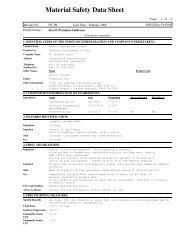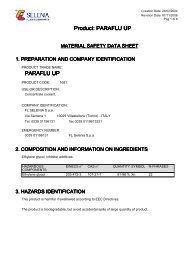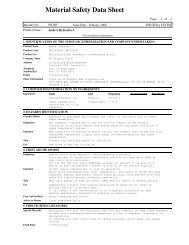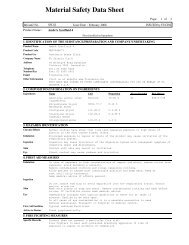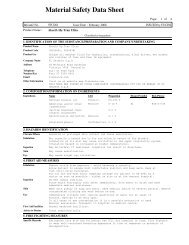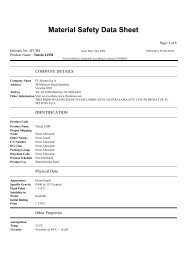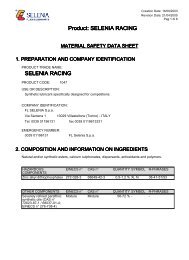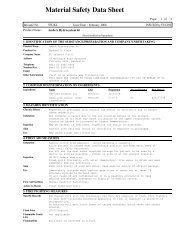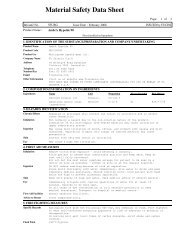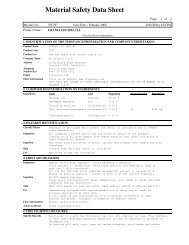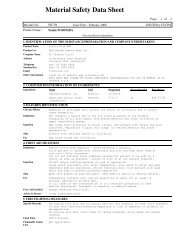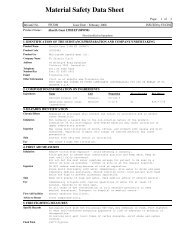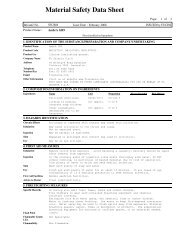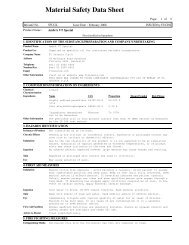Paraflu 11 - FL Selenia
Paraflu 11 - FL Selenia
Paraflu 11 - FL Selenia
Create successful ePaper yourself
Turn your PDF publications into a flip-book with our unique Google optimized e-Paper software.
Material Safety Data Sheet<br />
Page: 2 of<br />
Infosafe No. 5FULK Issue Date : February 2008 ISSUED by FUCHS<br />
Product Name :<br />
Hazardous<br />
Combustion Products<br />
Flash Point<br />
<strong>Paraflu</strong> <strong>11</strong><br />
Classified as hazardous<br />
Fire fighters to wear self-contained breathing apparatus if risk of<br />
exposure to vapour or products of combustion.<br />
EXTINGUISHING MEDIA: Water jets, water fog, foam, dry agent (carbon<br />
dioxide, dry chemical powder). Avoid high pressure water jet.<br />
Combustion products include oxides of carbon.<br />
Compoounds of nitrogen and products of incomplete combustion.<br />
120°C typical (open cup).<br />
Ignition Temperature 490°C (50% dilution)<br />
Flammable Limits<br />
LEL<br />
Flammability<br />
Explosion Data<br />
Not available<br />
Combustible liquid.<br />
Not available<br />
6. ACCIDENTAL RELEASE MEASURES<br />
Spills & Disposal<br />
7. HANDLING AND STORAGE<br />
Storage<br />
Slippery when spilt. Avoid accidents, clean up immediately. In event of large<br />
spill: Use absorbent (soil or sand, sawdust, inert material, vermiculite). Sweep<br />
up. Collect and seal in properly labelled drums for disposal. Wash area down with<br />
detergent and excess water. Contain - prevent contamination of drains and<br />
waterways.<br />
Wear protective equipment to prevent skin and eye contamination and<br />
inhalation of vapours.<br />
Refer to State Land Waste Management Authority for disposal.<br />
(Victoria:MMBW (03) 9615 6099)<br />
Classified as a C1 (COMBUSTIBLE LIQUID)<br />
8. EXPOSURE CONTROLS/PERSONAL PROTECTION<br />
National Exposure<br />
Standards<br />
Personal Protective<br />
Equipment<br />
Eng. Controls<br />
No value assigned for this specific material by the National Occupational<br />
Health and Safety Commission (Worksafe Australia).<br />
However, Exposure Standards for Ethylene glycol (vapour):<br />
(As published by the National Occupational Health and Safety Commission)<br />
TWA - 60 (mg/m3) STEL - 120 (mg/m3)<br />
Overalls or similar protective apparel. Safety glasses,goggles or faceshield as<br />
appropriate. Rubber gloves. Always work in a well ventilated area.<br />
Avoid skin and eye contact and inhalation of vapour and mist.<br />
Wear overalls, safety shoes, chemical goggles and impervious gloves.<br />
Use with adequate ventilation. If inhalation risk exists wear organic<br />
vapour/particulate respirator meeting the requirements of AS/NZS 1715 and<br />
AS/NZS 1716.<br />
Always wash hands before eating, smoking, drinking or using the toilet.<br />
Wash contaminated clothing and other protective equipment before storing<br />
or re-using.<br />
Must be sufficient to prevent breathing of vapour. Maintain concentration below<br />
recommended exposure limit.<br />
Vapour at elevated temperatures heavier than air - prevent concentration in<br />
hollows or sumps.<br />
DO NOT enter confined spaces where vapour may have collected.<br />
Keep containers closed when not in use.<br />
9. PHYSICAL AND CHEMICAL PROPERTIES<br />
Appearance<br />
Boiling Point<br />
Solubility in Water<br />
Specific Gravity<br />
(H2O=1)<br />
pH Value<br />
Vapour Pressure<br />
Vapour Density<br />
(Air=1)<br />
Green blue liquid.<br />
108°C (50% dilution)<br />
Completely soluble.<br />
1.138 @ 20°C typical<br />
7.6 (50% aq. soln by volume)<br />
Not available<br />
Not available<br />
5



